Strawberries are one of the most fastidious berries. Therefore, in order to obtain a good harvest, it is necessary to follow certain rules concerning its planting and further care for it. To preserve moisture in the soil, as well as to protect berries from contamination, weeds and diseases, special organic or inorganic agents are used. Let's look at the most popular materials used for planting strawberries.
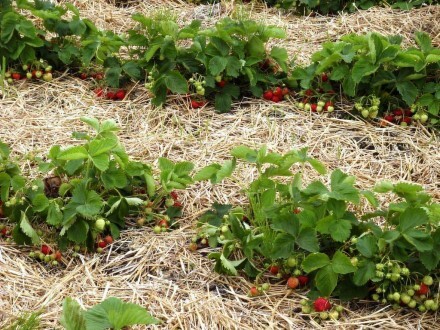
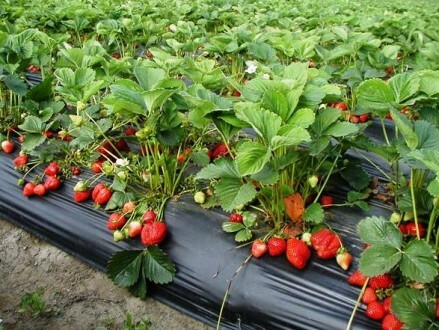
Need for mulching. Organic
In the process of planting strawberries, many experienced gardeners cover the surface of the earth with materials of organic origin. This process is called mulching. As a rule, for this purpose use:
- Fine sawdust( it is not necessary to use from coniferous trees).
- Finely milled peat.
- Straw.
- Compost.
- Dry grass or foliage.
- Thick paper or cardboard.
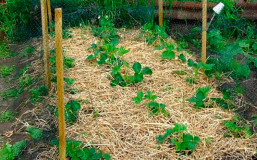 straw
straw 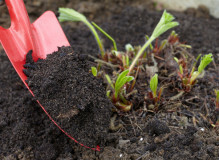 peat
peat 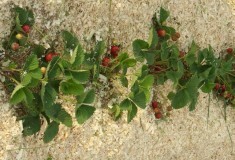 sawdust
sawdust Thanks to such materials, it is possible to protect berries from certain diseases( for example, from gray rot), as well as from exposure to moisture and contaminants after rain. In addition, mulching with organic materials allows you to preserve the looseness of the soil for a long time, and also to prevent the germination of weeds.
On the other hand, the above options are short-lived. Such mulch is prone to decay and decomposition, which can cause the appearance of pests, fungus and plant diseases.
Main advantages of mulching with organic materials
- Protection of the soil from rain erosion, as well as from the washing out of useful trace elements.
- Protection of berries and plants from various diseases.
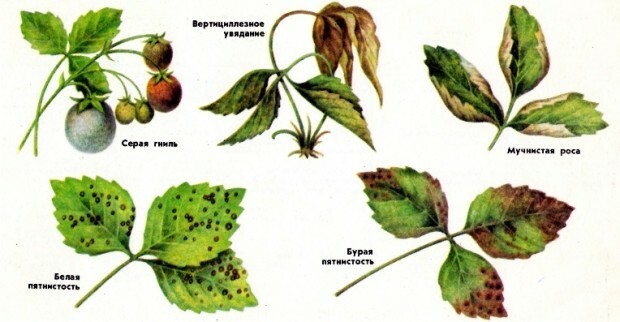
- Protection of berries from contamination.
- Reduces the degree of evaporation of moisture from the soil.
- Increasing the fertility of the land.
- Facilitating the care of strawberries.
- Moisture and looseness of soil for a long period.
Inorganic materials( characteristics and video)
Recently, artificial materials have been used frequently for mulching instead of organic steels. They cover the surface of the soil immediately before planting the seedlings. As a rule, polyethylene film, agglomerate, agglutination, etc. are used as such materials.
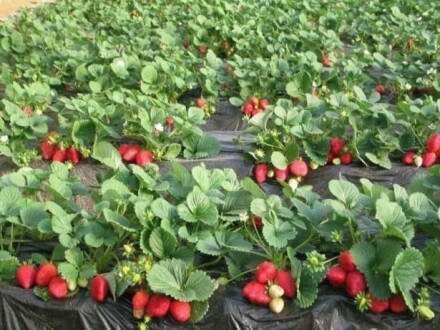 film
film 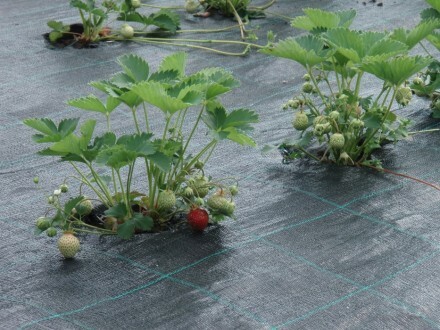 agrotechnic
agrotechnic Compared with organic, the synthetic materials for planting strawberries have the following advantages:
- Relative cheapness and availability.
- Longevity.
- High degree of protection against germination of weeds.
- The ability to protect the soil from excess moisture and ultraviolet radiation.
Unlike synthetic, organic materials do not need to be removed. They remain on the surface of the soil, rot and consequently increase the fertility of the soil. However, as mentioned above, this fact can cause the appearance of pests and the development of plant disease.
Species
The following types of synthetic strawberry covering materials are widely used today:
- Spunbelt is a non-woven fiber made from high-quality polypropylene. It is characterized by strength, lightness, high protective properties, as well as good water and light transmission.
- Spunbond is one of the varieties of non-woven covering material made from polymer melt. The term of its operation is 4 years.
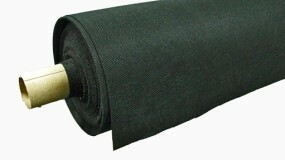 spunbond in roll
spunbond in roll 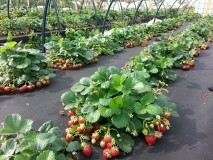 spunbond
spunbond
- Agrospan for strawberry is a fiber that uses a molten polymer and an ultraviolet stabilizer.
- Lutrasil is a light and durable material of high quality, created by German scientists. It can be white and black. The last type of film is used directly for sheltering strawberries.
All the above materials do not differ from each other in appearance. Therefore, often inexperienced gardeners have difficulties in choosing this or that option.
If you need to cover strawberries from weeds, protect it from pests and diseases, pay attention first of all to the density of the selected synthetic film. For these purposes, the product with a density of 17-30 g / m2 is best suited.m. As a rule, it has good heat, light and air conduction. With its help, you can create a favorable microclimate for the development and full growth of the plant.
- Light stabilized is a product that includes an ultraviolet light stabilizer. It perfectly protects the soil and plant from the influence of ultraviolet, keeps the heat well and helps to retain moisture, while maintaining the density and structure of the soil cover. A wide application was made of a film, one side of which is white and the other side is black.
- Reinforced - a product with a high degree of strength and resistance to mechanical damage. As a rule, it is used to cover greenhouses, and when planting strawberries, less dense and thin materials are used.
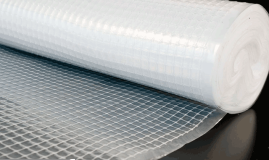 reinforced film in roll
reinforced film in roll 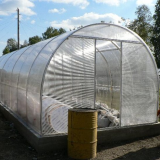 greenhouse from reinforced film
greenhouse from reinforced film
Polyethylene film is very good for sheltering strawberries in early spring. It allows the soil to warm up more quickly, helps protect the plant from excessive precipitation, or, on the contrary, helps to retain moisture in the soil. The only drawback - on hot days it can contribute to overheating of the soil and plants.
Agrotech
One of the newest developments for mulching the soil is agrotech. It is a solid polypropylene material, which is characterized by high strength and durability. Its surface can be crested or even.
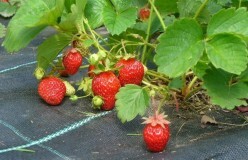
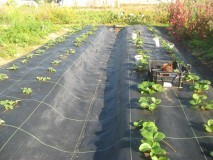
For convenience in the use on the surface of the agro-cloth, there is a marking by cells, the size of which is 15 × 15 cm. Cross-shaped slits for plants are made on it. Thanks to the agro-cloth, you can forget about frequent weeding, loosening of the soil and weeds. In addition, this product perfectly protects berries from dirt after rain.
Unlike other artificial covering materials, agro-cloth allows a good flow of moisture and air. After the rain, water does not accumulate on its surface and puddles do not form. Under it, the soil does not "suffocate" due to the special microclimate that creates this product.
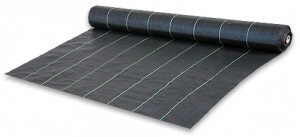 agglutinated on roll
agglutinated on roll 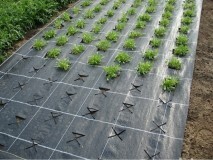 planting strawberries on agro-cloth
planting strawberries on agro-cloth As a rule, agrotextile has a dark color. Black material for strawberries does not let light, thus preventing the growth and development of weeds. Restricting air access to the weeds, you can cause their death and further decomposition.
White agglomerate is used primarily to protect the soil from ultraviolet radiation and overheating. In addition, some gardeners prefer to use the agglomerate of green and gray colors, which are made by specialized enterprises under the order.
Another important advantage of agrotkani is the protection of berries and the plant itself from pests. The fact is that for the activity and reproduction of some insects( for example, a spider mites) a primer is needed, and because of the covering material they do not have access to the ground. In this case, there is no need to use chemicals for spraying strawberry bushes.
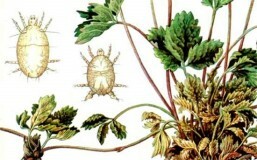 Strawberry mite does not reach the roots
Strawberry mite does not reach the roots  Agglutinated roots protects
Agglutinated roots protects Agro-tissue stimulates the reproduction in soil of earthworms and microorganisms useful for strawberry. They process organic remains of weeds and contribute to an increase in humus content in the soil.
Technology of landing( instruction and video)
Let's look at how to plant strawberries on the covering material. Initially, it is necessary to prepare a plot of land. To do this, perform the following actions:
- Choose a place for planting. It is better to prefer the site where previously grown cereals, onions, garlic or marigolds.
- Digs beds and cleans the ground of plant and weed residues.
- Soil is fed. As a fertilizer, you can use humus, straw or compost.
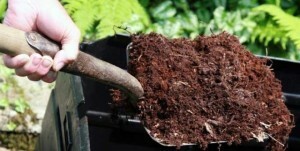 humus
humus 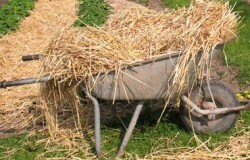 straw
straw
- Well moisturize the soil and form beds for planting strawberries.
- If you use a synthetic film to cover the ground surface, in this case a drip irrigation hose should be placed on the bed.
After all the above actions, you can proceed to plant strawberries on the covering material:
- Spread a synthetic cover on the bed. Rolling it on the surface of the earth, it is necessary to gradually fix the edges. Make sure that it fits snugly to the ground. As options for fixing, you can use pegs, sandbags, large stones or planks.
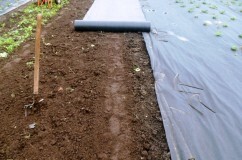 spread the agglomerates
spread the agglomerates 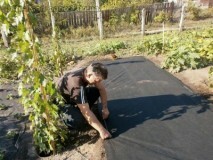 fix the agricultural fibers
fix the agricultural fibers
- If you are using a double-sided spunbond, spread it on the surface of the soil in such a way that the moisture-proof side is at the top( usually it is black).
- For planting strawberry bushes, make cross-section or round cuts on the surface of the film. This can be done with a conventional clerical knife or scissors. Slits should not be large. Their size should not be more than 15 cm.
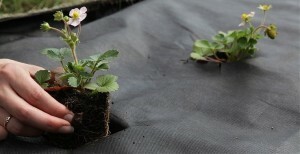 make cuts and plant seedlings.
make cuts and plant seedlings. 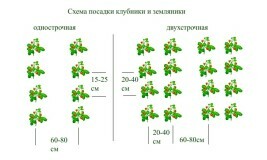 .
.
- planting pattern. Make indentations between cuts of 30 cm, and between rows - 40 cm. The space left will be enough for the normal development of the plant.
- Having carried out the above actions, you can go directly to planting seedlings.
A few words in favor of synthetic coatings
Undoubtedly, strawberries grow much better and develop on any surface than on the open ground. Such a method of planting is recommended by most experienced summer residents, who devoted a lot of time to growing garden berries. Understanding all the benefits of using agrofiber comes at the time of harvesting, which comes out large and abundant.
- Thanks to the process of mulching with artificial materials, you can significantly save your time while caring for berries. You completely forget that such frequent weeding and loosening of the soil, cleaning strawberries from dirt after the rain. Correctly sheltered land from the time of planting the bush to fruiting almost does not need care.
- Artificial coating is also an excellent means of getting rid of unnecessary tendrils produced by plants. It does not allow the roots of the strawberry to become entrenched, so that it is easier and quicker to detect and eliminate them.
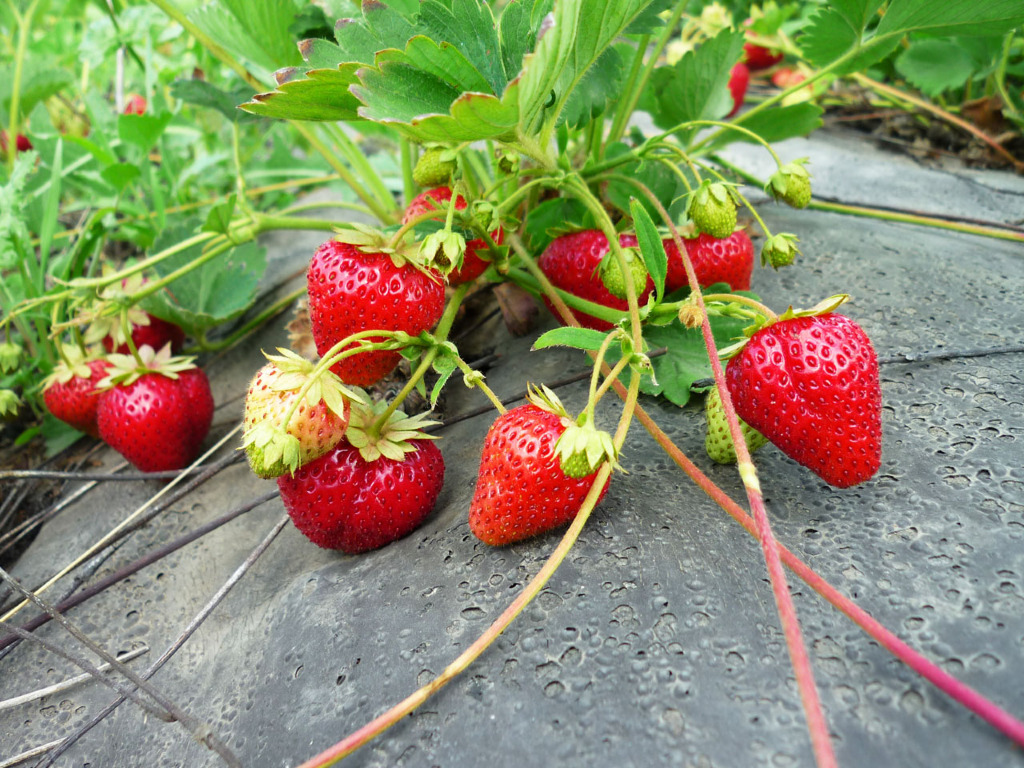
- Synthetic mulch fabric also has aesthetic appeal. With its help, the site acquires a neat appearance. Covering the earth with such material, you get territory on which only green strawberry bushes and bright red berries will be visible.
- It is quite easy to move over a film covered land. Due to the high degree of density, it does not tear underfoot and is resistant to mechanical damage. Despite this, when visiting the land is not recommended to wear shoes with sharp heels and metal rims on the sole.
Let's sum up. To protect strawberries from weeds and pests, improve yields, and retain moisture in the soil, organic and inorganic materials are often used. Organic include: sawdust, peat, straw, dry leaves and grass, and to inorganic - polyethylene film, agrotextile, spunbond, agrospan, lutrasil and spunbell. Before using the covering material, it is necessary to prepare the soil in advance. For this, it is cleared of weeds, loosened and fertilized.
Video:
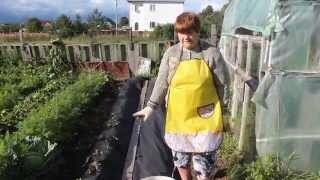 3:17
3:17 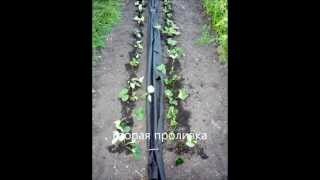 1:25
1:25  6:33
6:33 